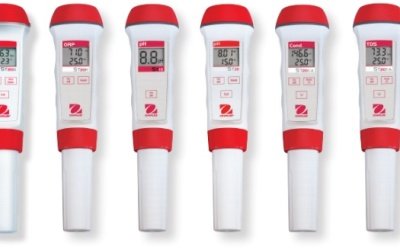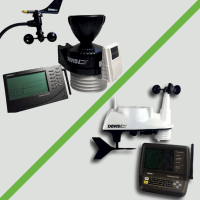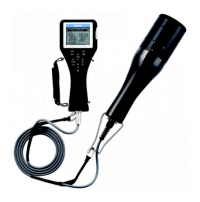Weather Stations; How to Read Specifications

Weather Stations are devices with multiple sensors used for collecting accurate weather data at a particular location. There is an enormous variety of stations available, each with different sensors, specifications, and capabilities. This abundance of choice can often mean searching for and selecting the right weather station for your needs, an arduous task. To help you make the search more manageable, the Instrument Choice Scientists have put together a list of terms and definitions you might find when searching through specifications.
Technical
Radiation Shield
A weather station radiation shield is to protect the temperature and humidity sensors from sources of radiated and reflected heat to help ensure accuracy in temperature and humidity result reporting.
Rain Gauge
Rain gauges are devices used to measure rainfall and rain rate. There are three main varieties of rain gauges. These are;
- Tipping bucket rain Gauge
- Weighing Rain Gauge
- Radar Rain Gauge
For a complete breakdown of each of the types, read the Instrument Choice article; ‘Rain Gauges – What Types Are the Main Types, and What Are the Benefits?’
Anemometer
An anemometer is an instrument used for measuring wind speed and wind direction.
Wind Vane
A wind vane is an instrument used to measure wind direction. The wind vane will move according to wind direction, and the arrow will point to the direction of the wind.
Wireless Range / Transmission Distance
On weather station specifications, this denotes the maximum allowable distance between a transmitter and receiver during regular operation.
Calculated Parameters
These are parameters that a weather station calculates or estimates based on other measured values from sensors. An example of a measured value is wind chill.
Accuracy
Accuracy is the closeness of a measurement to a specific value. Specifications will express the accuracy of a device as plus or minus a set amount.
Sample Rate/Time
The sample rate or sample time is the amount of time taken between weather parameter measurements.
Weather Parameters
Temperature
Temperature is the degree of heat present. A thermometer measures temperature and displays the reading as a scale. Most commonly, and depending on location or needs, this scale is either Celcius (°C), Fahrenheit (°F) or Kelvin (K).
Relative Humidity
The relative humidity is the amount of water vapour present in the air at a given temperature, expressed as a percentage. The higher the relative humidity percentage, the more humid the atmosphere. Relative humidity is an indicator of the likelihood of precipitation, fog, or dew. At 100% relative humidity is the dew point.
Dew Point
The dew point is the temperature where water vapour condenses into liquid water.
Heat Index
The heat index is a measure of heat, combining both air temperature and relative humidity in shaded areas to indicate a ‘feels like’ temperature to a human under current conditions.
Barometric Pressure
Barometric pressure, also known as atmospheric pressure, is the pressure within the atmosphere of the earth. Low-pressure systems are associated with clouds and precipitation that minimise temperature changes throughout the day, whereas high-pressure systems normally associate with dry weather and mostly clear skies with considerably more daily temperature changes due to higher radiation at night and more sunshine during the day.
Barometric pressure measurement units are in hPa or mmHg;
- hPa – A hectopascal unit is a multiple of the pascal (100Pa = 1 hPa). A pascal is an SI derived unit of pressure.
- mmHg – A millimetre of mercury is another unit of pressure measurement. Although not an official SI unit, it is still commonly used in meteorology
Rainfall
Rainfall is the current quantity of rain falling in a particular area at a specific time.
Rainfall rate is typically expressed in terms of length (depth) per unit time, for example; millimetres per hour or inches per hour.
Wind Chill
Windchill is the cooling effect wind has when blowing onto a surface.
Wind Direction
Wind direction the direction from which the wind originates.
Wind Speed
Wind speed is the rate the air is moving in a given area. Wind speed units include; miles per hour (mph), meters per second (m/s), Kilometers per hour (km/h), knots(kt), and Beaufort (B).
Lux
Lux is the SI unit for illuminance or amount of light. One Lux is equal to one lumen per square meter.
Forecast
A forecast is an estimate of future weather events.
Solar Radiation
Solar radiation is the electromagnetic radiation emitted by the sun.
Conclusion
When searching for a weather station, it’s essential to understand weather station specifications to select the best product for your needs and budget.
Need a bit more help with finding the perfect weather station or want to see more terms and definitions? Contact one of the Instrument Choice Scientists. We’re here to help! Call 1300 737 871 or email [email protected].
Also interesting
Instrument Choice is a specialist in weather stations and environmental monitoring solutions with an extensive range of models by Davis Instruments. The variety of stations available, all with different features and capabilities, makes it challenging to find the right configuration of features for your needs.
Instrument Choice scientists regularly test and review popular stations. Today they run their magnifying glass over the Davis Vantage Vue and Davis Vantage Pro 2 to compare inclusions, accuracy, resolution, and the transmission range of each unit.

Several water quality parameters must be measured before, during, and after construction to monitor environmental impacts. These will vary depending on local and state requirements and the type of construction you wish to undertake.
Today, we outline the most common water quality measurement factors and give some of the best examples of water meters capable of capturing the essential data.

